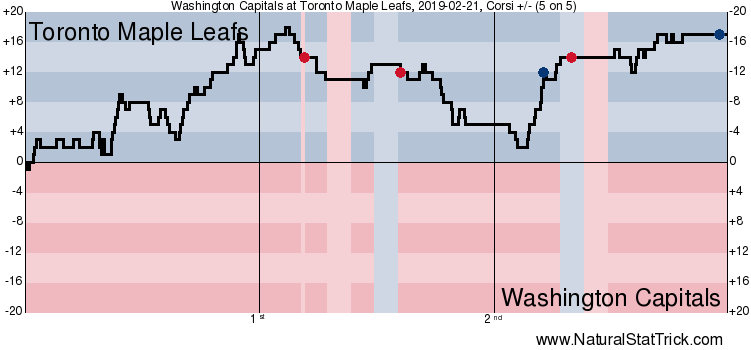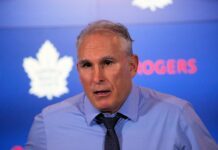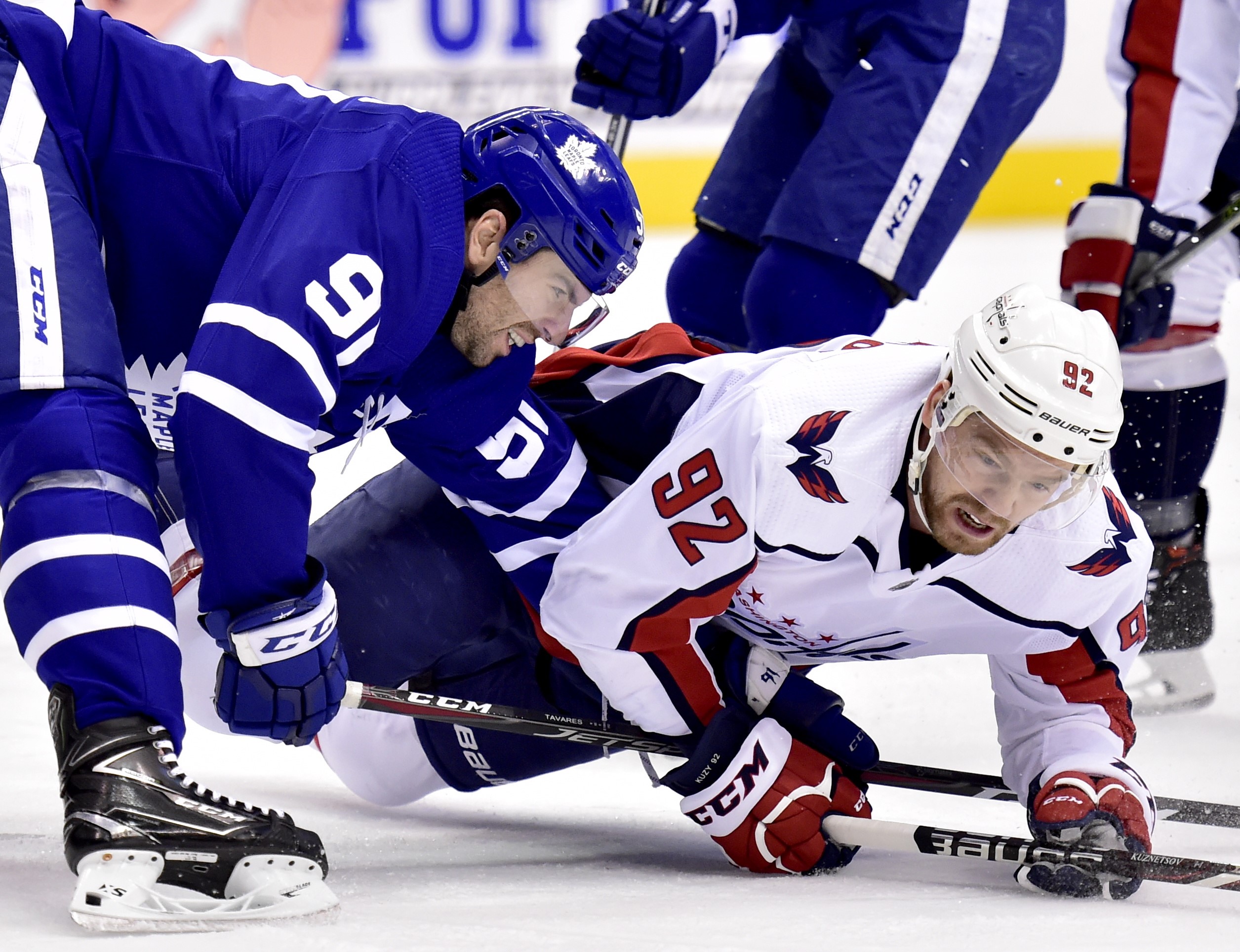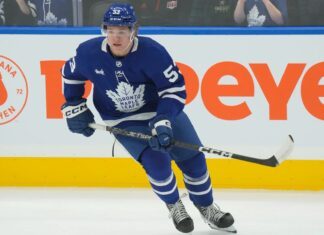The Toronto Maple Leafs lost their third game in a row for the first time this season after dropping the final game of the season series to the Washington Capitals on Thursday night.
Your game in ten:
1. It’s tough to sweep a team as good as Washington over a three-game season series. Braden Holtby was really good for the Caps and they decisively won the special teams battle with the power play goal and the shorthanded tally, which was the difference in the game.
If there was a disappointing part for me, it was the Leafs’ middle 20. The shorthanded goal against may have been the backbreaker — you felt reasonably confident the Leafs were going to tie the game up before that happened — but make no mistake, the Leafs lost this game in the second period. 0-0 score aside, there was lots to like about the first 20 minutes from the Leafs, but they came out for the second and got out-possessed 67-33 (5v5), out-chanced 9-2 (5v5), and outscored 2-0. There were two weak penalty calls in the second that hurt their momentum, but it’s not much of an excuse. The Leafs got outworked in the middle 20 and it cost them the game.
2. The Leafs hit game 60 by losing their third in a row for the first time this season. It was inevitable that it would happen at some point, so it’s not overly notable in and of itself, and they do have a point during the three-game skid (from the OT loss to St. Louis). What is more notable to me: With this loss, the Leafs are now on pace for 104 points, which is one fewer than they finished with last season.
3. To recap what changes were made between last year’s team and this year’s: Tavares, Ennis, Ozhiganov and Lindholm came in; Bozak, JVR, Komarov and Polak went out.
Expectations are rightfully raised this year. Tavares has been everything the team could’ve reasonably asked for; his late goal tonight — a really nice finish — puts him four shy of his career-high 38 with 22 games to go. Mitch Marner and Morgan Rielly have taken big strides forward. Auston Matthews is having a pretty similar season to his sophomore year (injury and all), while Nylander’s just now putting it together at the end of a bit of a lost (regular) season for him due to the contract situation. Frederik Andersen is having his best season as a Leaf. And yet the Leafs are sitting about where they were last season at Game #60: Facing down a third-place finish in the division with a Game 1 visit to Boston.
4. Andreas Johnsson’s recent play is a big revelation for the Leafs at the left wing position, where they would be in pretty dire straits without him elevating his game in the last 30 or so games. Babcock often says that it sometimes takes the coach a little while longer to make the lineup changes the fans or media might make, but it sounds to me he may have made a true believer out of Babcock finally based on his in-game promotion to Matthews’ wing tonight followed by the coach’s remarks after the game:
I thought his game has been real good. I think Johnny has been playing well. He is a guy who is tenacious. He is on the puck. He’s got good detail, and he seems to have good hands around the net. He finds way to score.
Babcock’s mention of the detail in Johnsson’s game seems notable as far as the growing trust level in the player.
The obvious move once Kadri is back is to finally pull the trigger on putting Johnsson – Matthews – Nylander together. Marleau – Matthews – Kapanen feels like a placeholder line that’s held its place too long; it’s had the occasional good night, but I’m not sure what Babcock has been doing there by going back to it time and again.
5. On the note about the LW, the reported inquiry on Chris Kreider makes all kinds of sense — he’s really the perfect LW for this team — but the cost is likely going to be far too prohibitive, if I were to guess.
6. Failing a Kreider-esque addition, here’s a radical idea that has zero percent chance of ever actually happening: Once he’s healthy, try Kadri on the LW and keep William Nylander at 3C. The idea being that the Leafs are in good shape down the right wing even with Nylander shifted over into the middle, and it upgrades the left wing internally.
I like the freedom playing center affords Nylander as far as opening up the ice for him to attack from either side of the ice. He looks amazing with the puck on his stick right now and the more touches he gets, the better. He’s weaving through the neutral zone, driving the D back, curling up, and making plays down the left and right side; he also reset a few times tonight by curling back during a line change (or a busted breakout) and set the Leafs up successfully on offense.
The possession numbers don’t lie — he led the team tonight with a 76% CF. I’m pretty confident in his ability to run over secondary competition playing in the middle.
It’s not going to happen, but it’s a fun thought.
7. Like with the Marleau – Matthews – Kapanen line, the plan for the defense pairings is a bit of a mystery right now. It’s obviously delusional at this point to think that Rielly – Hainsey is a credible matchup pair that can shut down arguably the best line in the league in Boston’s #1 line.
Muzzin – Rielly or Rielly – Muzzin showed promise before the plug was pulled on it pretty quickly. I agree Rielly is better on left and I understand the desire to acclimate Muzzin to a new team/system on his strong side, but they’re going to have to rip the bandaid off and adapt Muzzin to the right at some point. And there is no better time than the present — the more reps he can get there before the playoffs, the better.
Going from Rielly – Gardiner – Dermott down the left to Rielly – Muzzin – Gardiner with Dermott pushed to the right and Hainsey still paired off with Rielly is not the overall upgrade the Leafs were shooting for when they paid the price they paid to make the Muzzin acquisition.
We’ll see if another shoe is going to drop before the deadline on Monday as far as potential RHD additions (e.g. Nick Jensen) that might change the complexion, but it’s difficult to understand the vision right now from Babcock.
8. The other issue in need of addressing is the fourth line. It’s had some good nights here and there, but it’s not consistently effective enough and hasn’t been since Ennis – Gauthier – Leivo was broken up. Three combined goals from Lindholm and Gauthier speaks for itself, but the other factor is that, on a team that is monolithic up front — i.e. lacking in diversity as far as the amount of jam among the forward group — they don’t provide much of a spark physically. Are we looking at a third straight year where the Leafs fork over assets for a 4C at the deadline? It’s hard to believe, but maybe.
9. The other option (once healthy) is to go Ennis – Gauthier – Brown and hope it gels, but that would involve sitting Lindholm, who Babcock relies on for the penalty kill. A 4C upgrade who can play the PK certainly has its appeal, but my guess is Kyle Dubas is going to be hesitant to fork over much in the way of assets for one.
10. All the concerns I’ve outlined aside, I don’t want to raise alarm too much here — the Leafs are 6-3-2, have controlled 52.4% of the shot attempts (7th in the NHL) and 53.5% of the scoring chances (6th in the NHL) in the month of February. They’ve also scored 26 goals at 5v5, which is solid even-strength production.
It shouldn’t be overlooked just how much the Leafs lack of power play production is holding them back from reaching their true offensive potential right now. Since the turn of the new year, the Leafs have given up three shorthanded goals and scored just eight on the power play, three of which were scored in one game versus Colorado. They’ve got to figure this out.
Game Flow: 5v5 Shot Attempts














![John Gruden after the Leafs prospects’ 4-1 win over Montreal: “[Vyacheslav Peksa] looked really comfortable in the net… We wouldn’t have won without him” John Gruden, head coach of the Toronto Marlies](https://mapleleafshotstove.com/wp-content/uploads/2025/09/gruden-post-game-sep-14-218x150.jpg)












![John Gruden after the Leafs prospects’ 4-1 win over Montreal: “[Vyacheslav Peksa] looked really comfortable in the net… We wouldn’t have won without him” John Gruden, head coach of the Toronto Marlies](https://mapleleafshotstove.com/wp-content/uploads/2025/09/gruden-post-game-sep-14-100x70.jpg)







